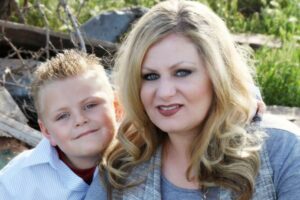For all of my life, I have struggled with my weight. When I was 23 and 346 pounds, I decided to get gastric bypass surgery. That is when my nightmare started.
After the surgery, I followed my doctor’s orders to walk as much as possible. However, I started experiencing chest pain about a week later and went to the ER. A CT scan showed that I had a blood clot in my lung, also known as a pulmonary embolism or PE.
The doctors told me that it was considered “provoked” due to my weight and my recent surgery. After treatment in the hospital, I went home and put the whole ordeal behind me.
Several years later, I had lost 166 pounds and was pregnant with my first son who was delivered via C-section. The night before I was supposed to be discharged, I experienced another PE.
This time around, I knew the pain all too well. Since I was told that my previous clot was caused by my weight, I had not thought to mention my blood clot history to my OB/GYN. Without this information, I was never given blood thinning injections to prevent blood clots during pregnancy and postpartum when your risk is elevated.
After I gave birth, I stayed in the hospital for 15 days. Not being able to come home with my newborn son was one of the hardest and most emotional situations that a new mother can go through.
My doctor said that it was unusual for a 26-year-old person to have this many blood clots, and decided to investigate further. He ordered testing for clotting conditions, and confirmed that I had protein C and S deficiencies.
Several years later, I was pregnant with my second child. I was afraid of clotting again, but my doctor said I would be fine as long as I took injection blood thinners every day. I followed orders and injected myself for nearly nine months, and I hated it. I had horrible black and blue bruises on each side of my body.
Unfortunately, the injections did not prevent a third PE. This time, I was able to leave the hospital with my baby, only to come back two days later. I had some other health issues as well, and I was in the hospital for about three months.
In telling my story, you may notice that I did not mention any signs of painful, red, or swollen legs. That’s because I did not have any of those signs.
My advice is that if you have had a blood clot and are considering pregnancy, make sure to talk to your doctor about your history of clotting and if genetic testing is recommended. Educate yourself as much as you can about blood clots and clotting conditions.
Resources
Women and Blood Clots
Know Your Risk
Signs and Symptoms of Blood Clots




